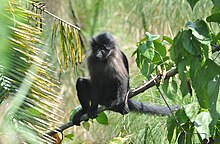Grey-cheeked mangabey
| Grey-cheeked mangabey[1] | |
|---|---|

| |
| Scientific classification | |
| Domain: | Eukaryota |
| Kingdom: | Animalia |
| Phylum: | Chordata |
| Class: | Mammalia |
| Order: | Primates |
| Suborder: | Haplorhini |
| Infraorder: | Simiiformes |
| Family: | Cercopithecidae |
| Genus: | Lophocebus |
| Species: | L. albigena
|
| Binomial name | |
| Lophocebus albigena (J. E. Gray, 1850)
| |

| |
| Grey-cheeked mangabey range | |
The grey-cheeked mangabey (Lophocebus albigena), also known as the white-cheeked mangabey, is an Old World monkey found in the forests of Central Africa. It ranges from Cameroon down to Gabon. The grey-cheeked mangabey is a dark monkey, looking in shape overall like a small, hairy baboon. Its thick brown fur is almost black in its forest home, with a slightly rufus/golden mane around the neck. The sexes are similar, with the males slightly larger than the females.
The grey-cheeked mangabey lives in a variety of habitats with the forests of Central Africa, it is generally thought to live in either swamp or primary forests, in some areas it has also been found in secondary forest as well. Some authors in the past have considered the species to be restricted to the forest canopy, however more recently habituated troops have been observed on the forest floor collecting food. It feeds primarily on fruit, particularly figs, taking other fruits seasonally, as well as shoots, flowers and insects.
The grey-cheeked mangabey lives in groups of between 5 and 30 individuals. The groups have either a single male or (more usually) several, without a single dominant male. Young males leave the troop once they are adult and join other troops, whereas the females stay in the troop of their birth. If troops become too large they may split. Confrontations between troops are rare, as this mangabey will usually avoid other troops. Their territories cover several square miles of forest, and can both overlap with other troops and shift over time.
Three subspecies of this mangabey were previously recognized. In 2007, Colin Groves elevated them all to species level, splitting one (johnstoni) into two species.[3]
References
[edit]- ^ Groves, C. P. (2005). Wilson, D. E.; Reeder, D. M. (eds.). Mammal Species of the World: A Taxonomic and Geographic Reference (3rd ed.). Baltimore: Johns Hopkins University Press. p. 160. ISBN 0-801-88221-4. OCLC 62265494.
- ^ Maisels, F.; Hart, J.; Olupot, W. & Oates, J.F. (2020) [amended version of 2019 assessment]. "Lophocebus albigena". IUCN Red List of Threatened Species. 2020: e.T12309A166607033.
- ^ Groves, Colin (2007). "The endemic Uganda mangabey, Lophocebus ugandae, and other members of the albigena-group (Lophocebus)". Primate Conservation. 22: 123–128. doi:10.1896/052.022.0112. S2CID 85061476.
External links
[edit]- IUCN Red List vulnerable species
- Lophocebus
- Primates of Africa
- Mammals of Burundi
- Mammals of Cameroon
- Mammals of the Central African Republic
- Mammals of the Republic of the Congo
- Mammals of the Democratic Republic of the Congo
- Mammals of Equatorial Guinea
- Mammals of Gabon
- Mammals of Rwanda
- Mammals of Tanzania
- Mammals of Uganda
- Mammals described in 1850
- Taxa named by John Edward Gray

